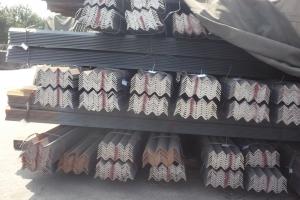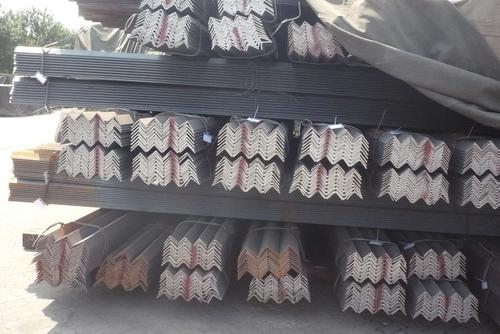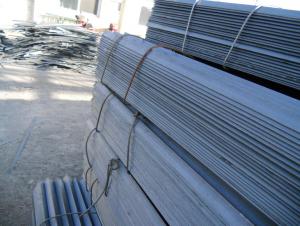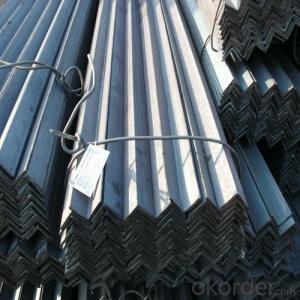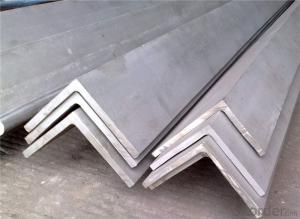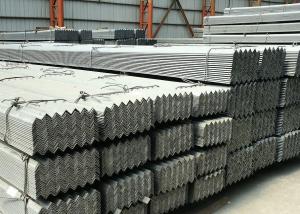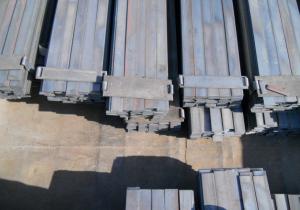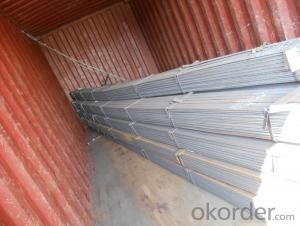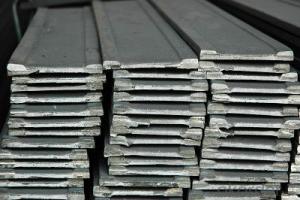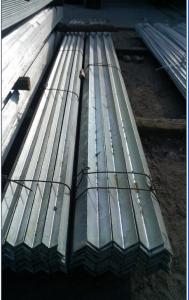Q235 Steel Angle Bar
- Loading Port:
- China Main Port
- Payment Terms:
- TT OR LC
- Min Order Qty:
- -
- Supply Capability:
- -
OKorder Service Pledge
OKorder Financial Service
You Might Also Like
Specifications of Angle Steel
1. Invoicing on theoretical weight or actual weight as customer request.
2. Length: 6m, 9m, 12m.
3. Sizes:
| Size(mm) | Mass(Kg/m) | Size(mm) | Mass(Kg/m) |
| 90*90*7 | 9.656 | 100*100*7 | 10.83 |
| 90*90*8 | 10.946 | 100*100*8 | 12.276 |
| 90*90*10 | 13.478 | 100*100*10 | 15.12 |
Payment terms:
1).100% irrevocable L/C at sight.
2).30% T/T prepaid and the balance against the copy of B/L.
3).30% T/T prepaid and the balance against L/C.
Material details:
Alloy No | Grade | Element (%) | | ||||
C | Mn | S | P | Si | | ||
| | |||||||
|
|
|
|
|
|
| |
Q235 | B | 0.12—0.20 | 0.3—0.7 | ≤0.045 | ≤0.045 | ≤0.3 | |
|
|
|
|
|
|
| |
Alloy No | Grade | Yielding strength point( Mpa) | | ||||
Thickness (mm) | | ||||||
≤16 | >16--40 | >40--60 | >60--100 | | |||
≥ | | ||||||
|
|
|
|
|
| | |
Q235 | B | 235 | 225 | 215 | 205 | | |
Alloy No | Grade | Tensile strength (Mpa) | Elongation after fracture (%) | | |||
Thickness (mm) | | ||||||
| ≤16 | >16--40 | >40--60 | >60--100 | | ||
≥ | | ||||||
|
|
|
|
|
|
| |
Q235 | B | 375--500 | 26 | 25 | 24 | 23 | |
*If you would like to get our price, please inform us the size, standard/material and quantity. Thank you very much for your attention.
- Q: Can steel angles be used for framing?
- Yes, steel angles can be used for framing. Steel angles are commonly used in construction for structural framing and support due to their strength, durability, and versatility. They can provide stability and reinforcement to various building structures, making them suitable for framing applications.
- Q: What are the different types of steel angles available?
- There are several different types of steel angles available, each designed for specific applications and purposes. Some common types include: 1. Equal Angle: Also known as L-shaped angles, these steel angles have equal side lengths and are often used for general structural and construction purposes. They provide excellent support and stability when connected to other structural components. 2. Unequal Angle: As the name suggests, unequal angles have different side lengths. These angles are commonly used in applications where one side needs to be longer or shorter than the other, such as supporting uneven loads or creating specific shapes. 3. Stainless Steel Angle: These angles are made from stainless steel, which is highly resistant to corrosion, making them suitable for applications where exposure to moisture or chemicals is a concern. They are often used in food processing plants, chemical industries, and marine environments. 4. Galvanized Angle: Galvanized steel angles are coated with a layer of zinc, providing excellent corrosion resistance. This makes them ideal for outdoor applications or areas with high humidity or saltwater exposure. 5. Rolled Steel Angle: Rolled steel angles are manufactured by rolling hot-rolled steel into the desired shape. This process enhances the strength and durability of the angle, making it suitable for heavy-duty applications. 6. Slotted Angle: Slotted angles have holes or slots along their length, allowing for easy attachment and adjustment. They are commonly used in shelving systems, workbenches, and storage racks, as they offer a versatile and customizable solution. 7. Structural Steel Angle: These angles are typically used in construction projects requiring load-bearing support. They are designed to withstand heavy loads and provide structural stability in buildings, bridges, and other infrastructure projects. It is important to consider the specific requirements of your project before choosing the appropriate type of steel angle. Consulting with a structural engineer or steel supplier can ensure that you select the right angle for your application.
- Q: Can steel angles be used for handrail supports?
- Yes, steel angles can be used for handrail supports. Steel angles are commonly used as a structural element in construction and can provide sufficient strength and stability to support handrails.
- Q: Are steel angles suitable for manufacturing shelving units?
- Absolutely, steel angles are absolutely fitting for the production of shelving units. Steel angles offer exceptional structural support and stability, rendering them an optimal selection for shelving systems. They possess the capability to endure substantial loads and evenly distribute weight, guaranteeing the sturdiness and endurance of the shelving units. Additionally, steel angles are user-friendly and can be customized to suit specific dimensions and designs. They also have resistance against corrosion and can withstand demanding environmental conditions, making them suitable for both indoor and outdoor shelving units. All in all, steel angles provide the strength, versatility, and dependability required for the production of top-notch and enduring shelving units.
- Q: What's the size of the 50 angle iron?
- Angle called angle, the steel strip is perpendicular to each other on both sides into the corner. There are equal angles and unequal angles. The two sides of an equal angle steel are equal in width.The specifications are expressed in millimeters of edge width * edge width * edge thickness. Such as "/ 30 x 30 x 3", that is 30 mm equilateral angle edge width edge thickness was 3 mm. Also available models that model is the number of centimeters wide, such as angle 3#. The model does not mean the size of the different edges and sizes of the same model. Therefore, the width, the edge and the thickness of the angle iron should be filled out in the contract and other documents, so as not to be indicated by the model alone. Standard Specification for hot-rolled equal angle iron is 2#-20#.
- Q: What are the cost considerations for using steel angles?
- There are several cost considerations to take into account when using steel angles. Firstly, the cost of the steel material itself can vary depending on the grade and quality of the steel. Higher-grade steel angles tend to be more expensive, but they offer better strength and durability. Additionally, the length and size of the steel angles will affect the overall cost. Longer and larger angles will generally be more expensive due to the increased amount of steel required. It is important to carefully assess the required dimensions to avoid unnecessary costs. Another cost consideration is the fabrication and finishing of the steel angles. If custom fabrication or special finishing techniques are required, such as welding, cutting, or painting, these processes can add to the overall cost. It is essential to factor in these additional expenses when budgeting for the use of steel angles. Transportation costs should also be considered. Steel angles are heavy and bulky, which can lead to higher shipping costs, especially for long distances. It is crucial to account for these expenses, particularly if the project requires a significant quantity of steel angles. Lastly, it is important to consider the long-term costs associated with steel angles. While steel is durable and long-lasting, it may require maintenance or protective coatings to prevent corrosion over time. These maintenance costs should be factored into the overall budget to ensure the longevity and reliability of the steel angles. Overall, the cost considerations for using steel angles include the price of the steel material, the dimensions and size of the angles, fabrication and finishing processes, transportation expenses, and long-term maintenance costs. Evaluating and planning for these factors will help ensure a cost-effective and successful use of steel angles in various applications.
- Q: What are the standard tolerances for steel angles?
- The tolerances for steel angles can vary depending on the angle's specific grade and size. Generally, dimensional tolerances and straightness tolerances are included in the standard tolerances for steel angles. Dimensional tolerances pertain to the allowable variations in the angle's dimensions, including thickness, width, and length. These tolerances are usually expressed as a range or the maximum allowable deviation from the specified dimensions. On the other hand, straightness tolerances deal with the permissible deviation from a straight line that the angle can have. This is typically assessed by placing a straight edge along the angle's length and measuring the maximum gap between the straight edge and the angle. It is important to highlight that the appropriate tolerances for steel angles should be determined based on relevant standards and specifications provided by industry organizations or regulatory bodies. These standards and specifications will offer the necessary guidance on the acceptable tolerances for steel angles based on their intended use and application.
- Q: Are steel angles available in non-standard sizes or custom shapes?
- Non-standard sizes or custom shapes of steel angles are indeed available. Although standard sizes of steel angles are commonly found in the market, there are manufacturers and suppliers who offer the flexibility to produce angles in non-standard sizes or custom shapes. This allows customers to fulfill their specific project requirements, be it for structural, architectural, or other applications. Custom shapes can range from unequal leg lengths to curved angles or angles with specific hole patterns. These non-standard sizes or custom shapes may necessitate special manufacturing processes, longer lead times, and potentially higher costs compared to standard sizes. Nevertheless, the availability of steel angles in non-standard sizes or custom shapes empowers customers to address unique design needs and achieve desired outcomes.
- Q: How do steel angles resist corrosion?
- Steel angles resist corrosion through the presence of a protective layer formed on their surface. This layer, known as a patina, is typically composed of iron oxide or iron hydroxide. It acts as a barrier, preventing direct contact between the steel and corrosive elements in the environment, such as moisture or chemicals. Additionally, steel angles can be galvanized or coated with anti-corrosive substances, offering further protection against corrosion.
- Q: What are the different types of steel angles connections for columns?
- There are several different types of steel angle connections for columns, including the bolted shear plate connection, welded connection, and clip angle connection. Each type of connection has its own advantages and disadvantages, and the choice of connection depends on factors such as the load requirements, design preferences, and ease of installation.
Send your message to us
Q235 Steel Angle Bar
- Loading Port:
- China Main Port
- Payment Terms:
- TT OR LC
- Min Order Qty:
- -
- Supply Capability:
- -
OKorder Service Pledge
OKorder Financial Service
Similar products
Hot products
Hot Searches
Related keywords
